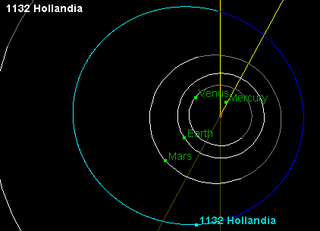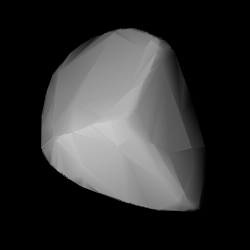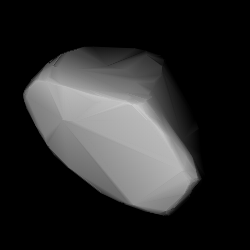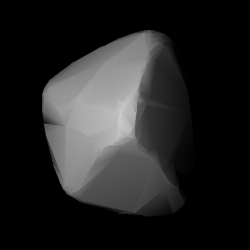Related Research Articles
4349 Tibúrcio, provisional designation 1989 LX, is a dark asteroid from the central region of the asteroid belt, approximately 29 kilometers in diameter. It was discovered on 5 June 1989, by German astronomer Werner Landgraf at ESO's La Silla Observatory in northern Chile.
Arago, provisional designation 1923 OT, is a dark asteroid from the outer regions of the asteroid belt, approximately 55 kilometers in diameter. It was discovered on 5 September 1923, by Russian astronomer Sergey Belyavsky at the Simeiz Observatory on the Crimean peninsula. The asteroid was named after French mathematician François Arago.
Pawlowia, provisional designation 1923 OX, is a background asteroid from the central regions of the asteroid belt, approximately 20 kilometers in diameter. It was discovered on 5 October 1923, by Soviet astronomer Vladimir Albitsky at the Simeiz Observatory on the Crimean peninsula. The asteroid was named after Russian physiologist and Nobelist Ivan Pavlov.
La Paz, provisional designation 1923 PD, is a carbonaceous asteroid from the outer region of the asteroid belt, approximately 40 kilometers in diameter. It was discovered on 31 October 1923, by German astronomer Max Wolf at the Heidelberg-Königstuhl State Observatory and named after the city La Paz in Bolivia.

1132 Hollandia, provisional designation 1929 RB1, is a stony asteroid from the middle region of the asteroid belt, approximately 27 kilometers in diameter. It was discovered on 13 September 1929, by Dutch astronomer Hendrik van Gent at Leiden Southern Station, annex to the Johannesburg Observatory in South Africa. It was named for the region Holland in the Netherlands.
1815 Beethoven, provisional designation 1932 CE1, is a carbonaceous background asteroid from the outer regions of the asteroid belt, approximately 30 kilometers (19 miles) in diameter. It was discovered on 27 January 1932, by German astronomer Karl Reinmuth at the Heidelberg Observatory. The uncommon F-type asteroid seems to have a long rotation period of 54 hours (tentative). It was named after Ludwig van Beethoven.
1295 Deflotte, provisional designation 1933 WD, is a carbonaceous asteroid from the outer regions of the asteroid belt, approximately 48 kilometers in diameter. It was discovered on 25 November 1933, by French astronomer Louis Boyer at the Algiers Observatory in Algeria, North Africa. The asteroid was named after the discoverer's nephew.

1555 Dejan, provisional designation 1941 SA, is an asteroid from the background population of the central regions of the asteroid belt, approximately 22 kilometers in diameter. It was discovered on 15 September 1941, by Belgian astronomer Fernand Rigaux at the Royal Observatory of Belgium in Uccle. The asteroid was named after Dejan Đurković, son of Serbian astronomer Petar Đurković.
4282 Endate, provisional designation 1987 UQ1, is an asteroid from the inner regions of the asteroid belt, approximately 10 kilometers in diameter. It was discovered on 28 October 1987, by Japanese astronomers Seiji Ueda and Hiroshi Kaneda at Kushiro Observatory (399) in Japan. It was named for amateur astronomer Kin Endate.
1421 Esperanto, provisional designation 1936 FQ, is a dark background asteroid from the outer regions of the asteroid belt, approximately 55 kilometers in diameter. It was discovered on 18 March 1936, by Finnish astronomer Yrjö Väisälä at the Iso-Heikkilä Observatory in Turku, southwest Finland. The presumed C-type asteroid has a rotation period of nearly 22 hours. It was named for the artificial language Esperanto.
1267 Geertruida, provisional designation 1930 HD, is a carbonaceous background asteroid from the inner regions of the asteroid belt, approximately 20 kilometers in diameter. Discovered by astronomer Hendrik van Gent at Johannesburg Observatory in 1930, the asteroid was later named after Geertruid Pels, sister of Dutch astronomer Gerrit Pels.
2126 Gerasimovich, provisional designation 1970 QZ, is a stony background asteroid from the inner regions of the asteroid belt, approximately 8 kilometers in diameter. It was discovered on 30 August 1970, by Soviet astronomer Tamara Smirnova at the Crimean Astrophysical Observatory in Nauchnyj, on the Crimean peninsula. The asteroid was named after Russian astronomer Boris Gerasimovich.

1182 Ilona, provisional designation 1927 EA, is a stony asteroid from the inner regions of the asteroid belt, approximately 14 kilometers in diameter. It was discovered by German astronomer Karl Reinmuth at the Heidelberg Observatory on 3 March 1927, and later named Ilona. Any reference to its name is unknown.
2140 Kemerovo, provisional designation 1970 PE, is a dark asteroid from the outer region of the asteroid belt, approximately 30 kilometers in diameter.
1303 Luthera, provisional designation 1928 FP, is a dark asteroid and the parent body of the Luthera family, located in the outermost regions of the asteroid belt. It measures approximately 90 kilometers in diameter. The asteroid was discovered on 16 March 1928, by astronomer Friedrich Schwassmann at the Bergedorf Observatory in Hamburg, Germany, and later named after German astronomer Robert Luther.
2043 Ortutay, provisional designation 1936 TH, is a dark asteroid from the outer regions of the asteroid belt, approximately 45 kilometers in diameter. The asteroid was discovered by Hungarian astronomer György Kulin at the Konkoly Observatory, Budapest, on 12 November 1936. It was named after Hungarian ethnographer Gyula Ortutay.

1197 Rhodesia, provisional designation 1931 LD, is a dark background asteroid from the outer regions of the asteroid belt, approximately 48 kilometers in diameter. It was discovered on 9 June 1931, by South African astronomer Cyril Jackson at the Union Observatory in Johannesburg. The likely C-type asteroid has a rotation period of 16.1 hours. It was named for Rhodesia, a former British colony and unrecognised state, which is now Zimbabwe.
1426 Riviera, provisional designation 1937 GF, is a bright asteroid from the central regions of the asteroid belt, approximately 16 kilometers in diameter. Discovered by Marguerite Laugier at the Nice Observatory in 1937, the asteroid was later named for the Côte d'Azur, also known as French Riviera.
1847 Stobbe, provisional designation A916 CA, is an asteroid from the middle region of the asteroid belt, approximately 23 kilometers in diameter.

2120 Tyumenia is a dark background asteroid, approximately 45 kilometers in diameter, located in the outer regions of the asteroid belt. It was discovered on 9 September 1967, by Soviet astronomer Tamara Smirnova at the Crimean Astrophysical Observatory in Nauchnyj, on the Crimean peninsula. The asteroid was named for the now Russian district of Tyumen Oblast in Western Siberia.
References
- 1 2 3 4 5 "1240 Centenaria (1932 CD)". Minor Planet Center. Retrieved 15 December 2018.
- ↑ "centenarian" . Oxford English Dictionary (Online ed.). Oxford University Press.(Subscription or participating institution membership required.)
- 1 2 3 Schmadel, Lutz D. (2007). "(1240) Centenaria". Dictionary of Minor Planet Names – (1240) Centenaria. Springer Berlin Heidelberg. p. 103. doi:10.1007/978-3-540-29925-7_1241. ISBN 978-3-540-00238-3.
- 1 2 3 4 "JPL Small-Body Database Browser: 1240 Centenaria (1932 CD)" (2018-10-20 last obs.). Jet Propulsion Laboratory. Archived from the original on 18 September 2020. Retrieved 15 December 2018.
- 1 2 3 "Asteroid 1240 Centenaria". Small Bodies Data Ferret. Retrieved 15 December 2018.
- 1 2 "Asteroid (1240) Centenaria – Proper elements". AstDyS-2, Asteroids – Dynamic Site. Retrieved 14 December 2018.
- 1 2 3 4 Nugent, C. R.; Mainzer, A.; Masiero, J.; Bauer, J.; Cutri, R. M.; Grav, T.; et al. (December 2015). "NEOWISE Reactivation Mission Year One: Preliminary Asteroid Diameters and Albedos". The Astrophysical Journal. 814 (2): 13. arXiv: 1509.02522 . Bibcode:2015ApJ...814..117N. doi:10.1088/0004-637X/814/2/117. S2CID 9341381.
- 1 2 3 4 Usui, Fumihiko; Kuroda, Daisuke; Müller, Thomas G.; Hasegawa, Sunao; Ishiguro, Masateru; Ootsubo, Takafumi; et al. (October 2011). "Asteroid Catalog Using Akari: AKARI/IRC Mid-Infrared Asteroid Survey". Publications of the Astronomical Society of Japan. 63 (5): 1117–1138. Bibcode:2011PASJ...63.1117U. doi:10.1093/pasj/63.5.1117. (online, AcuA catalog p. 153)
- 1 2 3 4 Tedesco, E. F.; Noah, P. V.; Noah, M.; Price, S. D. (October 2004). "IRAS Minor Planet Survey V6.0". NASA Planetary Data System – IRAS-A-FPA-3-RDR-IMPS-V6.0: IRAS-A-FPA-3-RDR-IMPS-V6.0. Bibcode:2004PDSS...12.....T . Retrieved 15 December 2018.
- 1 2 3 4 Mainzer, A. K.; Bauer, J. M.; Cutri, R. M.; Grav, T.; Kramer, E. A.; Masiero, J. R.; et al. (June 2016). "NEOWISE Diameters and Albedos V1.0". NASA Planetary Data System: EAR-A-COMPIL-5-NEOWISEDIAM-V1.0. Bibcode:2016PDSS..247.....M . Retrieved 15 December 2018.
- 1 2 3 Masiero, Joseph R.; Grav, T.; Mainzer, A. K.; Nugent, C. R.; Bauer, J. M.; Stevenson, R.; et al. (August 2014). "Main-belt Asteroids with WISE/NEOWISE: Near-infrared Albedos". The Astrophysical Journal. 791 (2): 11. arXiv: 1406.6645 . Bibcode:2014ApJ...791..121M. doi:10.1088/0004-637X/791/2/121. S2CID 119293330.
- 1 2 3 4 Mainzer, A.; Grav, T.; Masiero, J.; Hand, E.; Bauer, J.; Tholen, D.; et al. (November 2011). "NEOWISE Studies of Spectrophotometrically Classified Asteroids: Preliminary Results". The Astrophysical Journal. 741 (2): 25. arXiv: 1109.6407 . Bibcode:2011ApJ...741...90M. doi:10.1088/0004-637X/741/2/90. S2CID 35447010. (catalog)
- 1 2 Oey, Julian (September 2008). "Lightcurve Analysis of Asteroids from the Kingsgrove and Leura Observatories in the 2nd Half of 2007". The Minor Planet Bulletin. 35 (3): 132–135. Bibcode:2008MPBu...35..132O. ISSN 1052-8091.
- 1 2 3 4 "LCDB Data for (1240) Centenaria". Asteroid Lightcurve Database (LCDB). Retrieved 15 December 2018.
- ↑ Behrend, Raoul. "Asteroids and comets rotation curves – (1240) Centenaria". Geneva Observatory. Retrieved 15 December 2018.
- ↑ di Martino, M. (December 1984). "Physical study of asteroids - Lightcurves and rotational periods of six asteroids". Icarus. 60 (3): 541–546.ResearchsupportedbytheConsiglioNazionaledelleRicerche. Bibcode:1984Icar...60..541D. doi:10.1016/0019-1035(84)90162-3. ISSN 0019-1035.